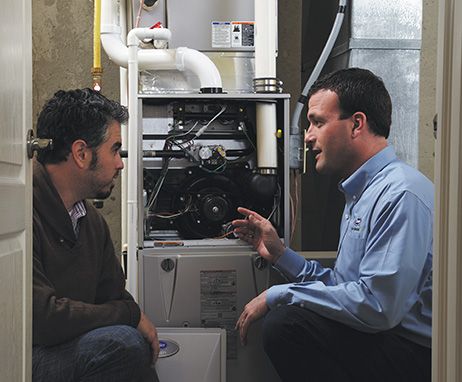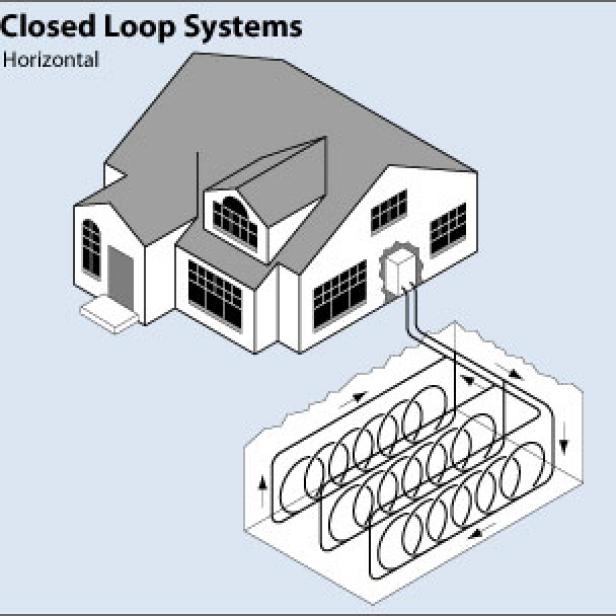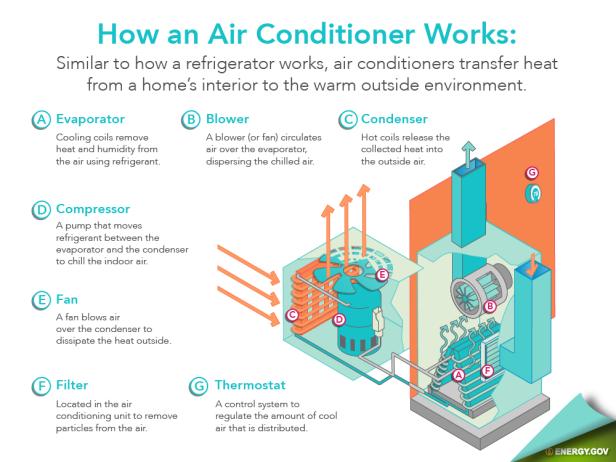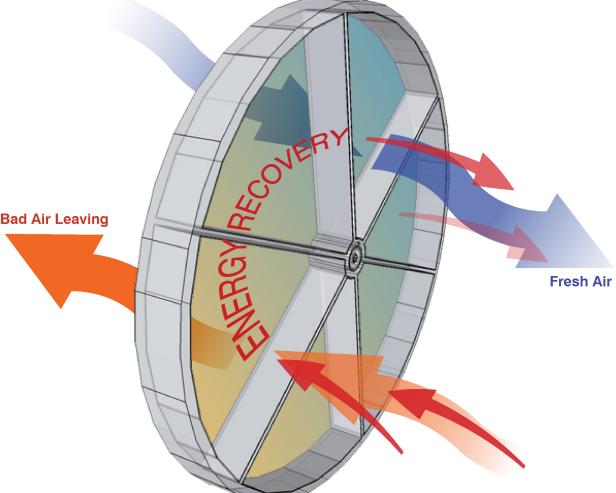Use these maintenance tips to help keep your air conditioning unit running efficiently.
By: Jeff Wilson
Most homes are heated and cooled through a central, whole-home, Heating, Ventilating, and Air-Conditioning system (HVAC). The HVAC may well be one of the most expensive and energy hungry systems in the home, so the more you know about your HVAC, the better. A well-informed homeowner will save money and have a healthier, more comfortable home.
HVAC System Components
Central HVAC systems are often called “split” systems because some of the components are installed inside the home and some of the components are installed outside a home. Inside your home, usually installed in the basement, attic, or a closet, you’ll find the furnace (oil, gas, or electric) and the evaporator portion of the air-conditioner. You’ll also find the blower (sometimes called an air handler), which serves both the furnace and the air-conditioner. Attached to the blower are ducts, which are tubes acting as pathways to deliver heated or cooled air to various rooms in the house.

The air-conditioner’s (or heat pump’s) condenser/compressor unit is installed outside the home. The furnace, evaporator, and blower are installed inside the home.
If your HVAC system is a heat pump, it won’t have a separate furnace. Dave Moody, an HVAC industry pro with Service Experts, explains, “A heat pump works like a regular air-conditioner in the summer, then essentially works in reverse in the winter, serving both cooling and heating purposes.” A heat-pump system will still have indoor and outdoor components.
Outside the house you’ll find the compressor and condenser components of the central air-conditioner (or heat pump), which are mounted in a metal cabinet with a large fan.
One alternative to a split-system is called a “packaged” system, in which all components are installed in a single unit outside the home, with ducts entering through the wall of the home. These units may be preferable for a homeowner who doesn’t want to waste space on the interior of their home with heating and cooling equipment.
Not often addressed in most HVAC installations is the “V” – ventilation. Most homes rely on infiltration, or air that seeps in through gaps and cracks in the home’s shell, for limited fresh air. Service Experts’ Moody says, “As indoor air quality (IAQ) is increasingly implicated as a big factor in human health problems, mechanical ventilation systems are becoming more commonplace.” More about that in the “ventilation” section below.
Heating
Oil or gas furnaces work by burning oil or gas in a sealed chamber. The blower circulates air around the outside of the chamber, where the air absorbs heat before it is circulated back into the home through the ducts. The byproducts of burning oil and gas are combustion gases, some of which are lethal. Those gases are vented to the outdoors via a metal or plastic flue pipe. Newer systems include a second pipe which gathers air from outside the home for the fire in the combustion chamber. Older systems pulled conditioned air from inside the home for this purpose. As that air was used in combustion, cold air from outside the home was pulled through cracks in the building’s shell, making the home feel drafty and cold, and lowering efficiency. “Newer furnaces, by bringing in outside air for combustion, don’t pull replacement air through a home’s gaps and cracks,” says Moody, “That means they’re more efficient, operate more safely, and make a home more comfortable than older furnaces.”
Electric furnaces use electric strip elements which convert electricity to heat, much like in a toaster or hair-dryer. Air from the house absorbs heat as it passes by the red-hot heating element. That air is then distributed to rooms in the home via the ducts. While quite simple, reliable, and safe, resistance heating is generally considered a less efficient and more expensive way to heat a home.
Heat pumps, either air-source or geothermal, are the most efficient way to heat and cool with electricity. Air-source heat pumps are the most common, and use a refrigerant or chemical to absorb heat from the air outside the home, concentrate it, and use the concentrated heat to warm the home. While quite efficient, air-source heat pumps can lose efficiency as the outside air get very cold. Geothermal uses heat energy from the earth for the same purpose. Since geothermal systems use heat from the ground, it’s immune to the very cold weather inefficiency that air-source heat pumps experience.
Cooling

Energy.Gov
Geothermal heat pumps use and store heat energy in the earth.
Cooling is achieved via the electric air-conditioner (or cooling cycle of the heat pump). Refrigerant gas (more commonly known by the trade name, Freon) is compressed by a compressor into a high pressure gas. The compressor pumps the high pressure gas through a radiator-like condenser coil of copper (or sometimes aluminum) tubing and aluminum fins where a large fan transfers heat to the outdoors. This is all accomplished in the outdoor component of your air-conditioning equipment. Next, the cooled, compressed, refrigerant liquid is pumped into the house via the copper tubing, arriving at the also radiator-like evaporator coil. There, under less pressure, it vaporizes from a liquid to a gas once again. A natural property of this change from liquid to gas is that the refrigerant absorbs heat rapidly from the air being blown through the evaporator by the blower. The cooled air is circulated through the home via the ducts. The refrigerant gas then heads back outside to the compressor, where the cycle starts over again.
Part of our discomfort in the summer comes from high humidity in the air which makes us feel sticky or clammy. So, at the same time the air in your home is being cooled by your air-conditioner, it’s also being dried. The blower draws warm, humid air from the home through return ducts and across the evaporator. Humidity from the warm, moist air condenses on the cool evaporator coil as liquid water, dripping into a drain pan below. The air leaving the evaporator is then not only cooler, but drier. That’s why we call it “air-conditioning” and not just “air-cooling.”

Ventilation
According to the EPA, indoor air is five times more contaminated than outdoor air. As a society, we’re spending more and more time indoors – as much as 90% of our time, by some estimates. That’s why indoor air quality (IAQ) is being implicated in health problems from asthma to cancer. An air filter can filter out large particles, but fumes from cleaning products, paints, furniture, and other sources can off-gas volatile organic compounds (VOCs) which can negatively affect our health. These are more difficult to filter from indoor air, so they should be vented to the outdoors.
Increasingly, mechanical ventilation is being integrated into the HVAC system to remove stale air from inside a home and bring in fresh air from outdoors. This can be as simple as a set of ducts with fans on timers which exhaust stale indoor air and bring in fresh outdoor air. A system like that, however, wastes energy. That’s why many newer homes and remodels are employing Heat Recovery Ventilators (HRVs) and Energy Recovery Ventilators (ERVs). These appliances attach to the existing duct system and add an exhaust duct and a supply duct to the outdoors. Then, the units exhaust stale air from the home and bring in fresh air from outside the home, but pass both air streams through an energy recovery medium which extracts the heating or cooling energy in the outgoing stale air. That energy is then passed into the incoming fresh air stream, reducing energy loss by up to 95% while still providing fresh air. Many mechanical ventilation units also include air filters to remove dust and allergens from incoming air.
Maintenance Tips for Your HVAC

Recoupaerator Rotary wheel: Ultimate Air An HRV or ERV will keep indoor air fresh while minimizing energy loss.
Keep your HVAC investment in tip-top shape for maximum comfort, energy efficiency, and long operating life:
· Change the blower filter at least twice a year – once before the heating season and once before the cooling season. More often if you live in a more dusty area.
· Keep components clean, especially the outdoor condenser/compressor unit. Remove dirt & debris, and cut back vegetation at least two feet on all sides.
· Use a programmable thermostat: When you’re away from home or at night when sleeping, allowing the temperature to fall (in the winter) or rise (in the summer) by 10 degrees for 8 hours or more can save 5%-15% on heating and cooling costs. With a heat-pump, however, only use this tip during the summer, as the heat pump’s heating cycle is more efficient when left at a steady temperature.
· Have your HVAC system serviced by a trained technician once a year. While there are cleaning tasks that most homeowners can accomplish, other tasks, like checking combustion in gas or oil furnaces or ensuring there are no leaks in a refrigerant line, are best left to experts.
· Insulate and air-seal your home properly – HVAC equipment is much more efficient if the home’s shell is efficient. (for a diy guide, check out this one from EnergyStar.gov.)
· When planning for a new HVAC system, whether installing for the first time or replacing an old system, insist that the HVAC contractor perform exhaustive “Manual J” calculations to calculate the system size. Systems that are either too small or too large will not run efficiently, provide poor comfort, not properly address the home’s humidity needs, and will likely fail earlier than necessary.
· In any home, regardless of whether gas or oil is used for HVAC or other purposes, install and maintain smoke and carbon monoxide alarms for your family’s safety.
· If you heat and cool with electricity, consider upgrading to geothermal heating and cooling. These systems cost a bit more up front, but they last up to twice as long as air-source heat pumps, operate more quietly, and save money on energy bills. As an option in these systems, waste heat generated by the air-conditioning cycle in the summer can be used to heat your domestic hot water for free.
